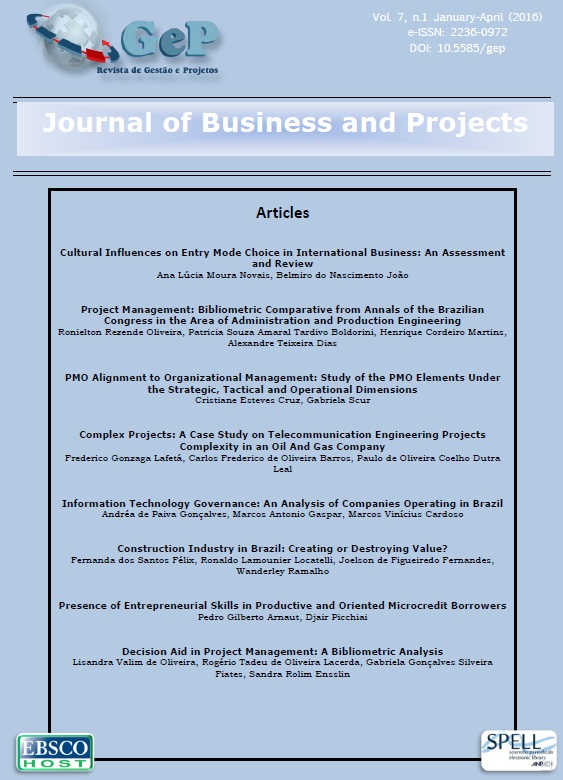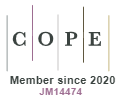Information Technology Governance: An Analysis of Companies Operating in Brazil
DOI:
https://doi.org/10.5585/gep.v7i1.374Keywords:
Information Technology, Information Technology Governance, Information Technology Maturity Level.Abstract
The information technology (IT) has been increasingly used to provide support to the control of the business, particularly in the complex current business environment, in which corporate governance has been increasingly required by society to the organizations. According to this context, the information systems areas of the companies also have developed actions focused on IT governance. This study aims to measure the level of maturity of IT governance in companies operating in Brazil. In order to achieve this goal, this descriptive qualitative research covered 107 large companies that operate in the country. The data were collected through a questionnaire of auto fulfillment, that was analyzed by statistical techniques. The main results show a high level of maturity of IT governance in the analyzed companies, which provides evidence that the IT governance had its development matured in analyzed companies. In addition, the prospected companies declared that their business are dependent of IT on some level and, moreover, that the higher levels of dependence were declared by the companies in which the IT governance maturity level was higher.
References
Albertin, A. L., & Albertin, R. M. M. (2008). Benefícios do uso de tecnologia de informação para o desempenho empresarial. Revista de Administração Pública, 42(2), 275-302.
Albertin, A. L., & Albertin, Dimensões do uso de tecnologia da informação: um instrumento de diagnóstico e análise. Revista de Administração Pública, 46(1), 125-151.
Broadbent, M. (2002, September) Creating effective IT governance. Proceedings of Gartner Symposium IT Expo, Miami, FL.
Buchwald, A., Urbach, N., & ; Ahlemann, F. (2014). Business value through controlled IT: toward an integrated model of IT governance success and its impact. Journal of Information Technology, 29, 128-147.
Cartlidge, A. (2007). An introductory overview of ITIL. New York: ITSMF, v. 3.
Chen, D. Q., Mocker, M., Preston, D. S., & Teubner, A. (2010). Information systems strategy: reconceptualization, measurement, and implications. MIS Quartely, 34(2), 233-259.
Cobo, A., Vanti, A. A., & Rocha, R. (2014). A fuzzy multicriteria approach for IT governance evaluation. Journal of Information Systems and Techology Management, 11(2), 257-276.
Culp, C. L. (2001). The risk management process: business strategy and tactics. New York: Wiley.
De Haes, S., & Van Grembergen, W. (2008, January). Analysing the relationship between IT governance and business/IT alignment maturity. Proceedings of Hawaii International Conference on System Sciences, Kauai, HW, USA, 41.
De Haes, S., & Van Grembergen, W. (2009). An exploratory study into IT governance implementations and its impact on business/IT alignment. Information System Management, 26(1), 123-137.
Fernandes, A. A., & Abreu, V. F. (2008). Implantando a governança de TI: da estratégia à gestão dos processos e serviços. Rio de Janeiro: Brasport.
Gama, F. A., & Martinello, M. (2006, setembro). Análise do impacto do nível da governança de TI em indicadores de performance de TI: estudo de caso no setor siderúrgico. Anais do Encontro Nacional da ANPAD, Salvador, BA, Brasil, XXX.
Gerow, J. E., Grover, V., Thatcher, J., & Roth, P. L. (2014). Looking toward the future of It-business strategic alignment through the past: a meta-analysis. MIS Quartely, 38(4), 1159-1185.
Gonçalves, A. P., Miranda, B. S., Pereira, R. S., & Correa, H. L. (2009, junho). Proposal of evaluation model of alignment between business and it strategies. Proceedings of CONTECSI, São Paulo, SP, Brasil, 7.
Heart, T., Maoz, H., & Plinski, N. (2010). From Governance to adaptability: The mediating effect of IT executives’ managerial capabilities. Information Systems Management, 27(1), 42-60.
Huang, S., Ou, C., Chen, C., & Lin, B. (2006). An empirical study of relationship between IT investment and firm performance: a resource-based perspective. European Journal of Operational Research, 173(3), 984-999.
Hughes, G. (2006). Five steps to IT risk management best practices. Risk Management, 53(7), 34-55.
Iso/Iec. (2014). Corporate governance of information technology. Recuperado em 20 dez. 2015 de http://www.itgi.com.
Itgi – Information Technology Governance Institute. (2007). COBIT 4.1. - Framework, control objectives, management guidelines and maturity models. New York: ISACA.
Itgi – Information Technology Governance Institute. (2011a). About IT Governance. Recuperado em 15 jan. 2011 de http://www.itgi.org.
Itgi – Information Technology Governance Institute. (2011b). Global status report on the governance of enterprise IT (GEIT). Rolling Meadows: ITGI.
King, J. L. (2001). Operational risk: measurement and modeling. Chichester: John Wiley & Sons.
Kingsford, R., Dunn, L., & Cooper, J. (2003, February). Information systems, IT governance and organizational culture. Proceedings of Australasian Conference on Information Systems, Western Australia, Australia, 14.
Li, Y., & Tan, C. H. (2013). Matching business strategy and CIO characteristics: the impact on organizational performance. Journal of Business Research, 66(2), 248-259.
Liang, T. P., Chiu, Y.C., Wu, S. P. J., & Straub, D. (2011, May). The impact of IT governance on organizational performance. Proceedings of Americas Conference on Information Systems, Detroit, MI, USA, 17.
Litan, R. E., & Wallison, P. J. (2000). The GAAP gap: corporate disclosure in the internet age. Washington: AEI-Brookings Joint Center for Regulatory Studies.
Lobler, M. L., Bobsin, D., & Visentini, M. S. (2008). Alignment between the strategic business plan and the plan of information technology at companies: the comparative analysis through the maturity level and critical sucess factors. Journal of Information Systems and Technology Management, 5(1), 37-60.
Luciano, E. M., & Testa, M. G. (2011). Controls of information technology management for Business processes outsourcing based on Cobit. Journal of Information Systems and Technology Management, 8(1), 237-262.
Luftman, J. N. (2000). Assessing business – It alignment maturity. Communications of AIS, 4, 67-88.
Luftman, J. N. (2004). Managing the information technology resource: leadership in the information age. New Jersey: Pearson Education.
Lunardi, G. L., Becker, J. L., & Maçada, A. C. G. (2010). IT Governance in Brazil: does it matter? London: Performance.
Magalhães, I. L., & Pinheiro, W. B. (2007). Gerenciamento de serviços de TI na prática: uma abordagem com base na ITIL. São Paulo: Novatec.
Melville, N., Kraemer, K., & Gurbaxani, V. (2004). Review: information technology and organizational performance: an integrative model of IT business value. MIS Quarterly, 28(2), 283-322.
Mendes da Silva, W., & Magalhães Filho, P. A. O. (2005, setembro). Verificando associações entre governança corporativa e governança de tecnologia de informação: uma análise empírica com indústrias brasileiras. Anais do Encontro da ANPAD, Brasília, DF, Brasil, XXIX.
Neely, A. (2005). The evolution of performance measurement research. International Journal of Operations & Production Management, 25(12), 1264-1277.
Nenickova, H. (2011). Critical success factors for ITIL best practices usage. Economics & Management, 16, 839-844.
Orozco, J., Tarhini, A., Masa’Deh, R., & Tarhini, T. (2015). A framework of IS/Business alignment management practices to improve the design of IT governance architectures. International Journal of Business and Management, 10(4), 64-83.
Pereira, R. F. de S., & Silva, M. M. da. (2010). ITIL Maturity Model. Recuperado em 03 jan. 2016 de http://ieeexplore.ieee.org/stamp/stamp.jsp?arnumber=5556698.
PMI – Project Management Institute. (2011). Sobre o PMI. Recuperado em 10 fev. 2011, de http://www.pmi.org/br.
Prestes, M. A., & Brodbeck, A. F. (2011). Desenvolvimento de um conjunto de processos de governança de tecnologia de informação para uma instituição hospitalar. Revista Eletrônica de Sistemas de Informação, 10(2), 23-42.
Radhakrishnan, A., Zu, X., & Grover, V. (2008). A process-oriented perspective on differential business value creation by information technology: An empirical investigation. Omega, 36(6), 1105-1125.
Ravishankar, M. N., Pan, S. L., & Leidner, D. E. (2011). Examining the strategic alignment and implementation success of KMS: a subculture-based multilevel analysis. Information System Research, 22(1), 39-59.
Rezende, D. A., & Abreu, A. F. (2002). Planejamento estratégico da TI alinhado ao planejamento estratégico de empresas. Revista de Administração Mackenzie, 2, 39-51.
Rodrigues, L. C.; Maccari, E. A., & Simões, S. A. (2009). O desenho da gestão da tecnologia da informação nas 100 maiores empresas na visão dos executivos de TI. Journal of Information Systems and Technology Management, 6(3), 483-506.
Scheeren, A. W., Fontes-Filho, J. R., & Tavares, E. (2013). Impacts of a relationship model on informational technology governance: an analysis of managerial perceptions in Brazil. Journal of Information Systems and Technology Management, 10(3), 621-642.
Schwarz, A., Kalila, M., Kefi, H., & Schwarz, C. (2010). A dynamic capabilities approach to understanding the impact of IT-enabled businesses processes and IT-business alignment on the estrategic and opertaional performance of the firm. Communications of the Association for Information Systems, 26, 57-84.
SEBRAE. (2008). Estudos e pesquisas. Recuperado em 10 jun. 2008, de http://www.sebrae.com.br.
Siqueira, J. (2011). O modelo de maturidade de processos: como maximizar o retorno dos investimentos em melhoria da qualidade e produtividade. Recuperado em: 14 jan. 2011, de http://www.ibqn.com.br/htm_artigos_links/index04.htm.
Sohal, A., & Fitzpatrick, P. (2002). IT Governance and management in large Australian organizations. International Journal of Production Economics, 75(1), 97-112.
Tarouco, H. H., & Graeml, A. R. (2011). Governança de tecnologia da informação: um panorama da adoção de modelos de melhores práticas por empresas brasileiras usuárias. RAUSP, 46(1), 7-18.
Van Grembergen, W., De Haes, S., & Guldentops, E. (2004). Structures, processes and relational mechanisms for IT governance. In Van Grembergen, W. (Ed.). Strategies for information technology governance. Hershey: Idea Group.
Vanni, R. M. P. (2005). Governança de TI na Universidade de São Paulo. São Paulo: USP.
Verhoef, C. (2007). Quantifying the effects of IT-governance rules. Science of Computer Programming, 67(2-3), 247-277.
Vitoriano, M. A. V., & Souza Neto, J. (2015). Information technology servisse management processes maturity in the brazilian federal direct administration. Journal of Information Systems and Technology Management, 12(3), 663-686.
Webb, P., Pollard, C., & Ridley, G. (2006, January). Attempting to define IT governance. Proccedings of Hawaii International Conference on System Sciences, Kauiai, HW, USA, 39.
Weill, P. (2004). Don't just lead govern: how top-performing firms govern IT. MIS Quarterly Executive, 3(1), 1-17.
Weill, P., & Woodham, R. (2002). Don’t just lead, govern: implementing effective IT governance. CISR Work Papers N. 326.
Weill, P., & Ross, J. W. (2006). Governança de tecnologia da informação. São Paulo: M. Books.
Wilkin, C., & Chenhall, R. (2010). A review of IT governance: a taxonomy to inform accounting information system. Journal of Information System, 24(2), 107-146.
Downloads
Published
How to Cite
Issue
Section
License
Copyright (c) 2016 Andréa de Paiva Gonçalves, Marcos Antonio Gaspar, Marcos Vinícius Cardoso

This work is licensed under a Creative Commons Attribution-NonCommercial-NoDerivatives 4.0 International License.
- Abstract 820
- PDF (Português (Brasil)) 1047







